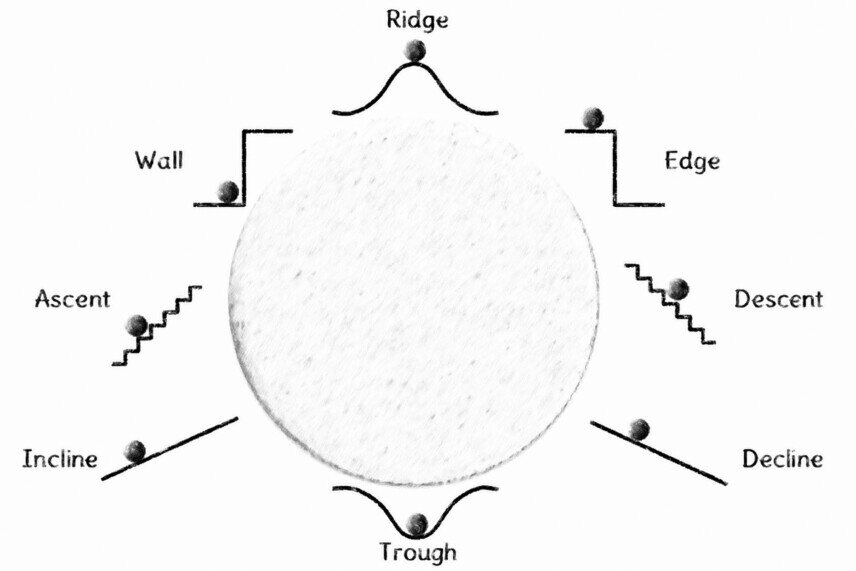Status circle
The current situation of people or organizations is deduced with the status circle. Thus visually clarifies the trends, the need for action, risks, positive or negative energies graphically. The assessment is done with the model's help and the core question: What is the current condition of the target group?

The status circle consists of eight segments: trough, incline, ascent, wall, ridge, edge, descent, and decline.
- Trough
The trough describes a stable equilibrium. As long as it is the desired condition, no sense of urgency exists. Examples are products established in the market, with few innovations to be expected, that continuously have continuous demand and available in most markets (e.g., Cola, Aspirin, Coffee).
In this case, the question is asked repeatedly, whether potential changes should be triggered with provoking initiatives.
- Incline
The incline is an indicator of a faltering increase. Since there is an upward trend, energy must be added continuously to cope with the slope. Examples are tasks (e.g., software, concept, or article development) that must be timely fulfilled and require continuous working.
In this situation, it should be avoided to increase the incline inadvertently more and more until the situation becomes a wall.
- Ascent
The ascent signals a gradual accomplishment of the increase. In this case, small, feasible steps are defined as milestones. As soon as a step is mastered, time is available to collect forces for the next step. Examples are projects with their tasks, dependencies, and milestones that achieve step-by-step results.
The feasibility has to be coordinated with the workload of the involved people.
- Wall
The wall indicates serious obstacles. In this case, the stepwise coping is not possible and needs special assistance for overcoming. Examples are crises (e.g., economic crisis, revolution), in which goals cannot be achieved with ordinary measures.
The simplest solution is an extended schedule that allows developing workarounds to bypass the hurdle.
- Ridge
The ridge refers to an unstable equilibrium. In this situation, it isn't easy to decide how, when, and where the future will be. A nudge can be sufficient to roll down the hill randomly. Examples are critical plants (e.g., nuclear power plants besides the ocean in territories with many earthquakes).
The direction of further development is determined actively with short-term measures.
- Edge
The edge is an indication of risky situations. The drop height is so threatening that massive damage must be expected. Examples are the missing availability of technical solutions (e.g., bandwidth, software) that are needed.
The safest way is to take a step backward and to look for alternatives.
- Descent
The descent marks gradual dismantling. Not every downtrend is bad. Slopes can be mastered safely with many small steps. Examples are incremental replacements of old systems by new ones.
The desired height of the steps determines the duration and risk of the way down.
- Decline
The decline determines an accelerating downswing. Because it goes down almost by itself, energy must be applied for braking not to lose control on the way down. An example is the creeping dissatisfaction of the staff in a change process.
The negative loop can be absorbed with early reactions to first signs of frustration and be reduced to an acceptable level, e.g., through measures that motivate the employees.

